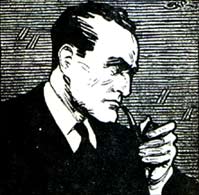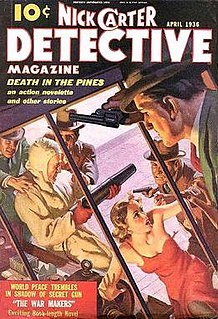Related Research Articles

Pulp magazines were inexpensive fiction magazines that were published from 1896 to the late 1950s. The term pulp derives from the cheap wood pulp paper on which the magazines were printed. In contrast, magazines printed on higher-quality paper were called "glossies" or "slicks". The typical pulp magazine had 128 pages; it was 7 inches (18 cm) wide by 10 inches (25 cm) high, and 0.5 inches (1.3 cm) thick, with ragged, untrimmed edges.

The dime novel is a form of late 19th-century and early 20th-century U.S. popular fiction issued in series of inexpensive paperbound editions. The term dime novel has been used as a catchall term for several different but related forms, referring to story papers, five- and ten-cent weeklies, "thick book" reprints, and sometimes early pulp magazines. The term was used as a title as late as 1940, in the short-lived pulp magazine Western Dime Novels. In the modern age, the term dime novel has been used to refer to quickly written, lurid potboilers, usually as a pejorative to describe a sensationalized but superficial literary work.
Disney Comics is currently a label of Disney Publishing Worldwide and was a comic book publishing company operated by The Walt Disney Company from 1990 to 1993. It was connected with W. D. Publications, Inc., which was a subsidiary of The Walt Disney Company that published "Disney Comics" during that time span. W. D. Publications, Inc. created Disney Comics in 1990 so that The Walt Disney Company would not have to rely on outside publishers such as Gladstone Publishing. In the US, Disney only licensed Disney comic books to other publishers prior to 1990.

Philip Marlowe is a fictional character created by Raymond Chandler. Marlowe first appeared under that name in The Big Sleep, published in 1939. Chandler's early short stories, published in pulp magazines like Black Mask and Dime Detective, featured similar characters with names like "Carmady" and "John Dalmas".

Sexton Blake is a fictional character, a detective who has been featured in many British comic strips, novels and dramatic productions since 1893. Sexton Blake adventures were featured in a wide variety of British and international publications from 1893 to 1978, comprising more than 4,000 stories by some 200 different authors. Blake was also the hero of numerous silent and sound movies, radio serials, and a 1960s ITV television series.
Argosy, later titled The Argosy and Argosy All-Story Weekly, was an American pulp magazine from 1882 through 1978, published by Frank Munsey until its sale to Popular Publications in 1942. It is the first American pulp magazine. The magazine began as a children's weekly story–paper entitled The Golden Argosy. In the era before the Second World War, Argosy was regarded as one of the "Big Four" pulp magazines, - the most prestigious publications in the pulp market, that many pulp magazine writers aspired to publish in. John Clute, discussing the American pulp magazines in the first two decades of the twentieth century, has described The Argosy and its companion The All-Story as "the most important pulps of their era."

All Star Comics is an American comic book series from All-American Publications, one of three companies that merged with National Periodical Publications to form the modern-day DC Comics. While the series' cover-logo trademark reads All Star Comics, its copyrighted title as indicated by postal indicia is All-Star Comics, with a hyphen. With the exception of the first two issues, All Star Comics told stories about the adventures of the Justice Society of America, the first team of superheroes, and introduced Wonder Woman.

Edward Zane Carroll Judson Sr., known by his pseudonym Ned Buntline, was an American publisher, journalist, and writer.

Nick Carter is a fictional character that began as a dime novel private detective in 1886 and has appeared in a variety of formats over more than a century.

Frank Merriwell is a fictional character appearing in a series of novels and short stories by Gilbert Patten, who wrote under the pseudonym Burt L. Standish. The character appeared in over 300 dime novels between 1896 and 1930, numerous radio dramas in 1934 and again from 1946 through 1949, a comic strip from 1928 through 1936, a comic book Frank Merriwell At Yale, and a 12-chapter serialized film in 1936. The book series was relaunched in 1965, but only three books were published.
Popular Publications was one of the largest publishers of pulp magazines during its existence, at one point publishing 42 different titles per month. Company titles included detective, adventure, romance, and Western fiction. They were also known for the several 'weird menace' titles. They also published several pulp hero or character pulps.
A Dime Western is a modern term for Western-themed dime novels, which spanned the era of the 1860s–1900s. Most would hardly be recognizable as a modern western, having more in common with James Fennimore Cooper's Leatherstocking saga, but many of the standard elements originated here: a cool detached hero, a frontiersman, a fragile heroine in danger of the despicable outlaw, savage Indians, violence and gunplay, and the final outcome where Truth and Light wins over all. Often real characters — such as Buffalo Bill or the famous Kit Carson — were fictionalized, as were the exploits of notorious outlaws such as Billy the Kid and Jesse James. Buffalo Bill's literary incarnation provides the transition from the frontier tales to the cowboy story, as he straddles both of the genres.
Frank Reade was the protagonist of a series of dime novels published primarily for boys. The first novel, Frank Reade and His Steam Man of the Plains, an imitation of Edward Ellis's The Steam Man of the Prairies (1868), was written by Harry Enton and serialized in the Frank Tousey juvenile magazine Boys of New York, February 28 through April 24, 1876. The four Frank Reade stories concerned adventures with the character's inventions, various robot-like mechanisms powered by steam.

Detective Story Magazine was an American magazine published by Street & Smith from October 15, 1915 to Summer, 1949. It was one of the first pulp magazines devoted to detective fiction and consisted of short stories and serials. While the publication was the publishing house's first detective-fiction pulp magazine in a format resembling a modern paperback, Street & Smith had only recently ceased publication of the dime-novel series Nick Carter Weekly, which concerned the adventures of a young detective.

Luis Philip Senarens (1865–1939) was an American dime novel writer specializing in science fiction, once called "the American Jules Verne".

Fame and Fortune Weekly: Stories of Boys Who Make Money (1905–1929) was an American periodical for children published by Frank Tousey in New York.
Golden Days for Boys and Girls was a late 19th-century children's story paper, distributed weekly as an accompaniment to the paper Saturday Night. Running from March 6, 1880 to May 11, 1907, Golden Days cost subscribers only $3 a year. It was the brainchild of newspaperman James Elverson (1838–1911), who later owned the Philadelphia Inquirer.

Captain Future was a science fiction pulp magazine launched in 1940 by Better Publications, and edited initially by Mort Weisinger. It featured the adventures of Captain Future, a super-scientist whose real name was Curt Newton, in every issue. All but two of the novels in the magazine were written by Edmond Hamilton; the other two were by Joseph Samachson. The magazine also published other stories that had nothing to do with the title character, including Fredric Brown's first science fiction sale, "Not Yet the End". Captain Future published unabashed space opera, and was, in the words of science fiction historian Mike Ashley, "perhaps the most juvenile" of the science fiction pulps to appear in the early years of World War II. Wartime paper shortages eventually led to the magazine's cancellation: the last issue was dated Spring 1944.
Frank Tousey (1853–1902) was among the top five publishers of dime novels in the late 1800s and early 1900s. Based in New York, his sensationalism drew a large audience of youth hungry for scenes of daring and tormented heroes and damsels in distress. Of particular notice in his approach to the ‘blood and thunder’ genre were the vivid cover illustrations of his dime novels, which were consistently larger and more thrilling than previous publications. Although focused on fictional weeklies, Tousey managed a variety of materials over time, including some handbooks, gossip sheets, and even a newspaper on current events in the Spanish–American War.